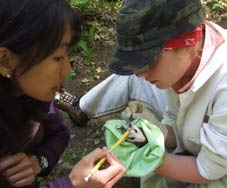Biodiversity and Human Disease – How EPA is Studying the Connections
Wednesday, October 8th, 2008 Each week we write about the science behind environmental protection. Previous Science Wednesdays.
Each week we write about the science behind environmental protection. Previous Science Wednesdays.
About the author: Montira Pongsiri, PhD, MPH, is an Environmental Health Scientist in EPA’s Office of the Science Advisor.
I was first associated with EPA as a STAR Fellow studying the risks and tradeoffs of using pesticides to control infectious diseases. Today, I’m an EPA scientist focusing on infectious diseases in the wider framework of ecosystem services, the direct and indirect benefits people derive from ecosystems.
The primary questions I am helping EPA explore are: What is the underlying mechanism of disease emergence, and do changes in biodiversity play a role?
Our research projects are unique in their interdisciplinary approach, involving ecologists, public health specialists, social scientists, and earth scientists, and also by including decision-makers early in the process to help ensure that new findings can be used to make better decisions.
 At one field site in northwest Connecticut, an opossum is checked for ticks, which are removed and collected to test for the presence of the Lyme disease bacterium, Borrelia burgdorferi. At one field site in northwest Connecticut, an opossum is checked for ticks, which are removed and collected to test for the presence of the Lyme disease bacterium, Borrelia burgdorferi. |
One area we’re studying is Lyme disease risk (chronicled previously by Melissa Anley-Mills and Aaron Ferster). Research partner Richard Ostfeld of the Cary Institute of Ecosystem Studies hypothesizes that a greater diversity of native mammal hosts could help decrease the risk of people getting Lyme disease. How? People get Lyme disease through tick bites, and ticks acquire the Lyme disease agent by feeding on mammals such as mice and squirrels. Not all mammals are equally efficient, or “competent,” in transmitting the disease agent to the ticks. So perhaps having a greater diversity of mammalian species, with their varying capabilities of transmitting the pathogen, could “dilute” the rates by which ticks get infected. Lower rates of tick infection equal lower risk of human infection.
There is also a connection between animal diversity and landscape condition. Forest destruction and fragmentation in the U.S. have been shown to reduce mammalian species diversity and to increase populations of the white-footed mouse—the most competent host of Lyme disease.
With the support of a new STAR grant, Ostfeld and his colleagues are testing this hypothesis by manipulating mammalian host communities in forest fragments and studying the effects on pathogen transmission rates.
When we better understand the mechanisms linking biodiversity and human disease through this and other research studies, we may be able to develop environmentally-based and behavioral approaches to both promote conservation as well as to reduce the risk of human disease – a win-win for environment and public health.
In addition to the Cary Institute of Ecosystem Studies, other EPA research partners include the CDC, Yale, NASA Ames, UCLA, the Institute for Bird Populations, Rutgers, and the NJ Department of Environmental Protection.
